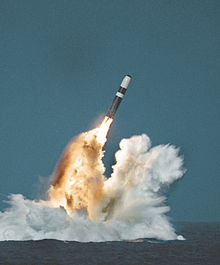UGM-133 Trident II
This article needs additional citations for verification. (November 2008) |
 A Trident II launch from a submerged submarine. | |
| Function | SLBM |
|---|---|
| Manufacturer | Lockheed Martin Space Systems |
| Size | |
| Height | 13.41 metres (44.0 ft) |
| Diameter | 2.11 metres (83 in) |
| Mass | 58,500 kilograms (129,000 lb) |
| Stages | 3 |
| Launch history | |
| Status | Active |
| Launch sites | LC-46, Cape Canaveral Ohio class submarines Vanguard class submarines |
| First flight | 1987-01-15[1] |
The UGM-133 Trident II, or Trident D5 is a Submarine-launched ballistic missile, built by Lockheed Martin Space Systems in Sunnyvale, California, and deployed with the Royal Navy and US Navy. It was first deployed in 1990, and is still in service.
The Trident II was developed in response to the development of a large number of heavy, increasingly accurate, MIRVed ICBMs, such as the R-36, by the Soviet Union. These missiles seriously threatened the survival of Minuteman III missiles in their silos. If the Soviet Union could have knocked out the majority of these missiles and strategic bombers on ground, it would have left the United States with no retaliatory capabilities for the response.
The Trident II was designed to be more sophisticated than the Trident I, and have a greater payload capacity. It is accurate enough to be used as a first strike weapon. All three stages of the Trident II are made of graphite epoxy, making the missile much lighter. The Trident II is carried by British Vanguard class and US Ohio class submarines. The USS Tennessee was the first submarine to be armed with Trident IIs. Trident II missiles are currently carried by twelve Ohio class, and four Vanguard class SSBNs. There were 127 consecutive successful test launches of the D5 missile since 1989 with the most recent being carried out on th 26th of July 2009 from the British HMS Victorious.[2]
The development contract for the Trident II was issued in October 1983. The first Trident II launch occurred in January 1987, and the first submarine launch was attempted by USS Tennessee (SSBN-734, the first D-5 ship of the Ohio class) in March 1989. The launch attempt failed because of problems with the first stage engine nozzle, and these problems delayed the IOC (Initial Operational Capability) of the Trident II until March 1990. [3]
Specifications
- Purpose: strategic nuclear deterrence
- Unit Cost: US$30.9 million
- Range: 11,300 kilometres (7,000 mi)
- Maximum speed: > 6,000 m/s (>21,000 km/h).[4]
- Guidance system: inertial, with Star-Sighting, GPS.
- CEP: 90-120 m (300-400 ft) (with GPS guidance), ~120 m without GPS using the Mark 5 RV.[5]
- Warhead (in USA usage only): nuclear MIRV. Up to eight W88 (475 kt) warheads (Mark 5) or eight W76 (100 kt) warheads (Mark 4). The Trident II can carry 12 MIRV warheads but START I reduces this to 8 and SORT reduces this yet further to 4 or 5.
Boats currently armed with Trident II missiles
- USS Alabama (SSBN-731)
- USS Alaska (SSBN-732)
- USS Henry M. Jackson (SSBN-730)
- USS Kentucky (SSBN-737)
- USS Louisiana (SSBN-743)
- USS Maine (SSBN-741)
- USS Maryland (SSBN-738)
- USS Nebraska (SSBN-739)
- USS Nevada (SSBN-733)
- USS Pennsylvania (SSBN-735)
- USS Rhode Island (SSBN-740)
- USS Tennessee (SSBN-734)
- USS West Virginia (SSBN-736)
- USS Wyoming (SSBN-742)
See also
References
- ^ Wade, Mark. "Trident". Encyclopedia Astronautica. Retrieved 2008-11-22.
- ^ Trident II D5 Missile Achieves 127 Successful Test Flights
- ^ Parsch, Andreas. "UGM-133". Directory of U.S. Military Rockets and Missiles. Retrieved 2009-02-14.
- ^ http://www.designation-systems.net/dusrm/m-133.html
- ^ http://www.designation-systems.net/dusrm/m-133.html
